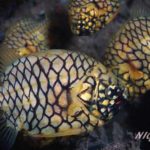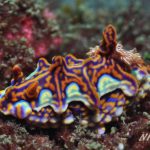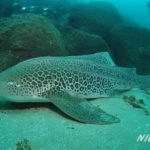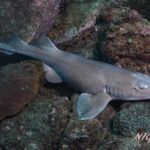Queensland’s Gold Coast is Australia’s version of Disney World with theme parks galore. But just off shore at the southern end of the “Goldie” as locals call it, lies Cook Island, home to a wide array of marine life including nudibranchs, stingrays, turtles, wobbegong sharks and even leopard sharks during the summer. If you’re visiting the Gold Coast, scuba diving Cook Island is not to be missed.
Diving Cook Island
While it’s mainly known for theme parks and surfing, there are many wonderful dive sites off Australia’s Gold Coast, a stretch of coastline that runs from southern Queensland to northern New South Wales. Cook Island is easily one of the best all-weather sites.
Named after the famous English explorer James Cook, the island was once called Turtle Island because its rocky reefs are home to a large population of sea turtles. Located about ½-mile (600 m) off Fingal Head, Cook Island is easily accessible by boat from the Tweed River. All around the island are rocky reefs in depths from 15 to 60 feet (5 to 18 m). There are a variety of sites; Northern Ledges is one of the best to see turtles.




Northern Ledges
This site, on the normally sheltered northern side of the island, features a rocky wall that drops from 15 feet to 36 feet (5 to 11 m). On the top of the wall are coral gardens, anemones full of anemonefish, abundant small reef fish and plenty of green turtles. Turtles gather here for a cleaning, and it’s common to see a dozen or more lingering in the shallows. These turtles are quite used to divers and will allow you to get very close for photos. Still, remember to respect their space.
Most divers spend their time on the rocky wall observing moray eels, wobbegongs, crayfish, bullseyes, gropers, leopard blennies, blind sharks, boxer shrimp, pipefish, lionfish and even pineapplefish. It’s also a great spot for macro photography with loads of small critters and a good variety of colorful nudibranchs, including exotic Spanish dancers.
While many divers stick to the wall, the sand flats beyond are also home to large and small marine life. You may see spotted and ornate wobbegongs, sleeping turtles, blue-spotted stingrays, round ribbontail rays and large white-spotted shovelnose rays. In summer, numerous leopard sharks gather here and you can see them resting on the bottom. A closer look will also reveal flatworms, nudibranchs, scorpionfish, velvetfish, cowry shells, ghost pipefish, mantis shrimp and the occasional seahorse.
Mary’s Rock
Off the very northern end of Cook Island is Mary’s Rock, a pinnacle surrounded by gutters, walls and caves in depths to 60 feet (18 m). Pelagic fish, wobbegongs, turtles, eagle rays, gropers and even gray nurse sharks inhabit the area. The rocky reefs are also covered in lovely hard and soft corals, pretty sponges, black coral trees, gorgonians, ascidians and sea ferns.
Other sites
You can only dive the eastern side of Cook Island when the seas are calm. In this area you’ll find numerous ledges and caves in depths from 20 to 40 feet (6 to 12 m). Take a torch to explore these caves as it will help to spotlight the resident banded wobbegongs, loggerhead turtles, brown-banded bamboo sharks, crayfish, soapfish, squirrelfish, slipper lobsters, lionfish, gropers and pineapplefish.
The southern side of Cook Island features another boulder wall dropping to 50 feet (15 m). You’ll find lovely hard and soft corals and common reef fish such as morwong, wrasse, angelfish, butterflyfish, grubfish, hawkfish, pufferfish, gobies, blennies and leatherjacks. This is also a good spot to see green and hawksbill turtles, wobbegongs and pelagic fish. Manta rays visit a small bommie in the area during the summer over the summer months to get cleaned.
One of the best sites off the western side of Cook Island is a site called Turtle Bommie. This rocky reef is always a great dive, with wobbegongs, turtles, stingrays, stingarees, crayfish and abundant reef fish.
Diving Cook Island is possible any time of the year, with visibility typically 20 to 40 feet (6 to 12 m) and generally clearest after a spell of southerly winds. The island is a marine reserve and a number of dive operators visit Cook Island each weekend. Being an all-weather site there is always somewhere to dive.
Deborah Dickson-Smith is one half of Diveplanit, a dive travel website she manages with her partner Simon Mallender, based in Australia. Underwater photographer Nigel Marsh also contributed to this story.
The post Scuba Diving Cook Island, Australia appeared first on Scuba Diver Life.
from Scuba Diver Life https://ift.tt/2IgPS4c
No comments:
Post a Comment